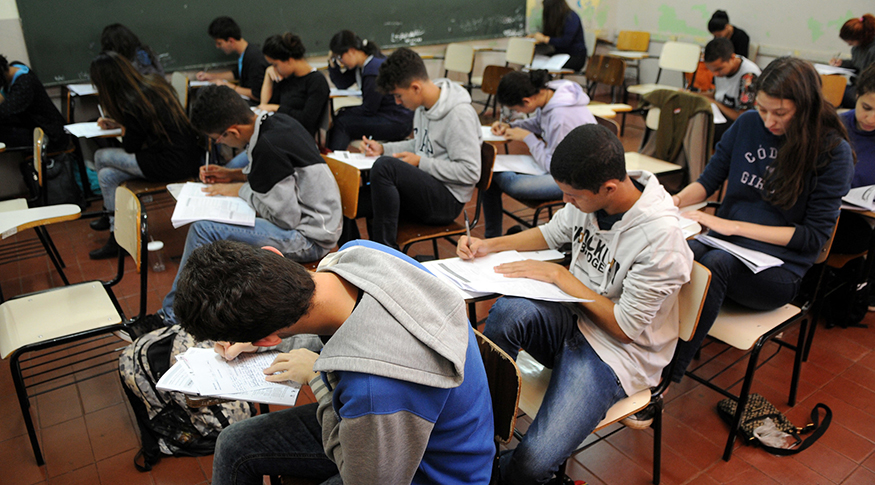Continuous PNAD
Necessity of working and lack of interest are major reasons for school dropout
July 15, 2020 10h00 AM | Last Updated: July 17, 2020 04h55 PM

Necessity of working, lack of interest and pregnancy are the main reasons causing Brazilian youngsters to stop their studies. Among the almost 50 million aged 14 to 29 in the country, about 20.2% did not conclude at least one of the levels of basic education. They amount to a total 10.1 million persons, being 58.3% men and 41.7% women Among those, 71.7% were black or brown and 27.3% were white. These are some of the data in the Education module of the Continuous National Household Sample Survey (Continuous PNAD), which presents the scenario of the education sector in 2019.
Necessity of working was the main reason reported for half of the men in that age group for having dropped out of school or for never having attended school, and the lack of interest was the reason for 33.0%. The inexistence of a school, of vacancies or of a desired shift were reasons reported by 2.7% and only 0.7% mentioned household tasks as a reason for their absence from school. Among women, the lack of interest was the main reason (24.1%) very close to the necessity of working and of pregnancy (both with 23.8%), followed by household tasks (11.5%).
Necessity of working was the main reason for youngsters in all the Major Regions, with highest rates in the South (48.3%) and Central West (43.1%) and the lowest ones in the Northeast (34.1%). The lack of interest in studying was the second main reason reported, always above 25%, with highlight to the Northeast, with 31.5%.
“These two main reasons together reached about 70% of the youngsters, regardless of the Major Region and indicate the need of measures to incentive the permanence of youngsters in school. The illiteracy in the country (6.6%) has been decreasing steadily, reaching almost the universalization of education. Raising the level of schooling up to the conclusion of high school seems to be a challenge,” says Adriana Beringuy, manager of the survey.
According to the researcher, in the case of women, pregnancy as a reason for school dropout is another aspect to be observed in terms of public policies. “Regarding that issue the South has a significantly lower index (6.4%), with almost half of the Major Region with the highest index, the North (12.7%),” Ms. Beringuy adds.
The passage from elementary to high school is crucial in terms of school dropout. The percentage of youngsters who stopped their studies at the age 15 is almost twice as that in preceding age brackets. Up to age 13, about 8.5% had quit school. At the age 14, the rate is 8.1%, but, at 15, it reaches 14.1% at, at 16, to 17.7%, reaching 18.0% at the age 19 and over.
“It is of fundamental importance that we find ways of making education more attractive and of enabling youngsters to balance work and studies at older ages. Public policies should get to identify what is wrong when a person between 15 and 19 years of age is compelled to quit school,” Ms. Beringuy highlights.
The age pattern remains similar between men and women and between white persons and black or brown ones. In regional terms, however, there are some differences. Early school dropout (up to age 13) was highest in the North (9.7%), Northeast (9.0%) and Southeast (8.7%). The Southeast kept a percentage of dropout at age 14 similar to that of the youngest group and the South was a highlight with 9.9% of school dropout.
On the other hand, the 15 year of age issue is observed in all the Major Regions, being most visible in the South (16.3%), Southeast (14.9%) and Northeast (13.9%). For youngsters between 16 and 18 years of age, the North and the Northeast recorded dropout percentages between 14.0% and 16.4%, reaching, respectively, 26.6% and 22.2% at the age 19 and over.
"That increased dropout at older ages is probably associated with the effort made by those students to make up for the previous school failure, " Marina Fortes Águas, IBGE analyst highlights.
Considering data of 2019, school failure or dropout affects 12.5% of the children and teenagers aged 11 to 14 and 28.6% of those aged 15 to 17. Among youngsters 18 to 24 years of age, almost 75% were behind in school or had dropped out of it, with 11.0% behind in school and 63.5% who did not attend school and had not finished compulsory basic education.
White youngsters are the majority in regular education integrated with technical or teacher training courses
Seen as one of the alternatives to make high school more appealing, technical education remains a reality for few. In 2019, in Brazil, only 7.1% of the 9.3 million students enrolled in high school (either in regular or adult and youth education modes) were attending a technical high school or teacher training course (directed to child and elementary education). The percentage of those enrolled in technical high school courses alone (6.6%) was statistically similar to that in 2018 (6.2%)
The percentage of white persons who attended high school courses integrated with a technical or teacher training course was bigger (7.8%) than that of black or brown persons (6.6%). In terms of sex, there was no difference between the percentages.
What increased between 2018 and 2019 was the search for professional qualification. In 2019, among the almost 171 million persons aged 14 and over, 15.6% (26.7 million) had once attended some type of professional qualification course, 2.5 percentage points more than in 2018 (13.1%).
Nevertheless, attendance to professional qualification courses increases with the level of schooling. Among persons without schooling or with complete elementary school. 7.4% had attended such courses at a given moment in the past. Among persons with incomplete high school up to incomplete higher education, that figure was about 20.9% and among those with complete higher education, it reached 25.8%.

